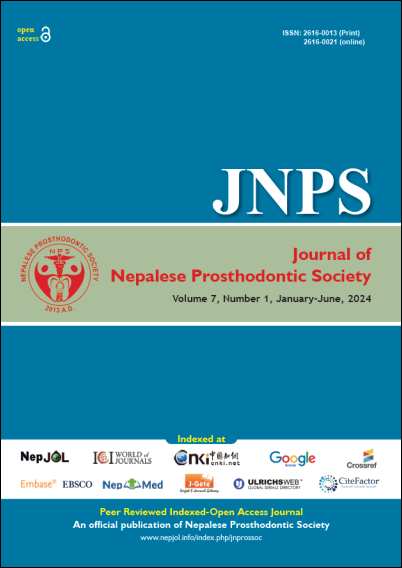Gender wise comparative study of mesiodistal width of crown among patients attending Dhulikhel Hospital
DOI:
https://doi.org/10.3126/jnprossoc.v7i1.70454Keywords:
Canine, Central Incisor, Lateral Incisor, Mesiodistal, Vernier CaliperAbstract
Introduction: Tooth dimension is an important consideration in treatment planning as the size of teeth is required for replacement or restoration. The aim of this study was to determine the mesiodistal width of six anterior natural teeth in maxilla. This would be helpful in selecting artificial teeth and also for better esthetics.
Methods: The sample consists of 368 patients (184 male 184 female) visiting the Dental Outpatient Department of Dhulikhel Hospital for a period of 3 months (November 2022 to January 2023). Impression of maxillary arches were made with alginate and poured in dental stone. Measurement of widest mesiodisatal width of labial surface of anterior six teeth was done with the digital vernier caliper by two observers on the casts. Independent t test was applied to compare the mean measurement between gender. Statistical analysis was done using statistical package for social sciences (SPSS version 21). The level of significance was set at p-value <0.05.
Results: Mesiodistal width of both right and left maxillary central incisor, lateral incisor and canine were significantly higher in males than in females (p<0.001, p<0.001and p<0.001, respectively).
Conclusions: Statistically significant difference was observed in mesiodistal tooth width between males and females, where the males showed higher mean values. The results of the mesiodistal tooth width obtained could be helpful to dental practitioners in prosthodontic and esthetic treatment planning.
Downloads
Downloads
Published
How to Cite
Issue
Section
License
Copyright (c) 2024 The Author(s)

This work is licensed under a Creative Commons Attribution-NonCommercial-NoDerivatives 4.0 International License.
This license enables reusers to distribute, remix, adapt, and build upon the material in any medium or format, so long as attribution is given to the creator. The license allows for commercial use. © The authors




